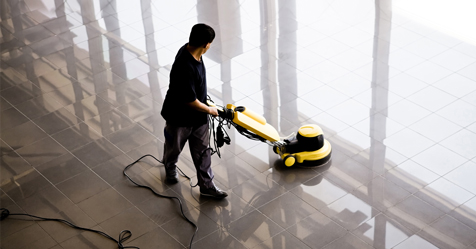The U.S. Green Building Council’s Leadership in Energy and Environmental Design certification program now requires the installation of high-performance mats at all building entries. Because the mats reduce the amount of soil that enters the building, fewer cleaning solutions are necessary to maintain the facility. Whenever fewer cleaning solutions are used, cleaning has a reduced impact on the environment, which is also the goal of green cleaning.
However, there are two caveats to these benefits:
- First, the mat must be categorized as “high-performance.” A high-performance mat typically has a rather long warranty, and as the name implies, is designed to more effectively capture and trap soils and moisture. Mats of this type are usually purchased, not rented.
- Second, for these mats to work effectively, they require maintenance and cleaning. Just like carpet, soils collect in the fibers of the mat. While the soil may not be noticeable, the more soiling a mat collects, the less effective the mat becomes.
Often managers and contractors believe the only maintenance mats require is routine vacuuming. However, that’s just the beginning of the care required for mats located at building entries or installed over hard surface walkways.
Entry and Indoor Mats
Because entry and indoor mats are the most frequently used types of mats, managers and contractors need to understand how to clean and care for them to ensure they continue to meet the high-performance standards we expect.
Mats placed at building entries and on walkways within the facility are typically made of nylon fibers. Similar to caring for carpet, an effective mat cleaning program involves daily cleaning, interim cleaning, and restoration.
Daily Cleaning
Daily cleaning involves vacuuming. Depending on foot traffic, indoor mats require vacuuming at least once per day, but the frequency of cleaning may increase in areas where foot traffic is heavy. Take care to avoid vacuuming wet mats.
Interim Cleaning
Because mats are designed specifically to capture soils, interim cleaning may be necessary monthly, or weekly or biweekly in heavily trafficked areas. This differs from interim cleaning for carpet, which may occur every two or three months. By interim cleaning, we are referring to dry cleaning methods, such as encapsulation.
For proper interim cleaning, it is very important to select high-quality encapsulating chemicals that do not leave sticky residues in the mat. Residue causes the mat to resoil very quickly, which minimizes its effectiveness. Because this type of cleaning is dry, the mat can be put into service very quickly. Additionally, encapsulates that remain in the carpet fibers continue to remove soils with each subsequent vacuuming.
Restorative Cleaning
Just as with carpet, restoration—or carpet extraction—is the most effective way to clean these types of mats.
Place the mat on a clean, dry, hard surface. If the mat collects a considerable amount of grease, tar, or oil, a hot water system will often prove most effective. Pre-spray the mat first and allow for sufficient dwell time for the cleaning solutions to work. Apply extra cleaning solution in those areas that are most noticeably soiled. If the bulk of the soiling is dry soil and moisture, pre-spray as discussed, but a cold water system will likely to the job.
Allow at least two hours or more for the mat to dry. Reduce the drying time considerably by placing the mat on a flat area and using an air mover over the mat. If you do not reinstall the mat immediately, it is very important not to roll it up. This can weaken the backing of the mat. Instead, store the mat flat on a clean surface.
Ongoing Care
While a high-performance mat is pretty hardy and should provide years of service, there are some ways to enhance its lifespan and also keep the mat working effectively. For instance, although it may not always be possible, try to install the mat on a flat surface. If the surface is uneven or sloped, it can cause the mat to wear and weaken in specific areas, shortening its lifespan. Also note that when matting is placed on top of some types of carpet, the matting can move or become a tripping hazard.
Additional care steps:
- As with carpeting, spots and gum may collect on the mat. Remove them as soon as they are brought to your attention.
- Check the surface underneath the mat. Moisture may develop under the mat, which has the potential to weaken the backing. If the surface is moist, remove the mat until it is dry.
- If two or more mats are installed in a building entry, make sure the ends of the mats touch. This allows each mat to work more effectively, helps prevent the mat from curling, and protects the edging of the mat.
- Rotate the mats. Usually certain areas of a facility get more foot traffic than others. Rotating the mats helps to improve their lifespan by spreading the wear and tear of foot traffic.
- If a mat has become saturated with moisture, such as after a heavy rain, either use a carpet extractor to clean the mat or use a wet/vac to remove the moisture.
Finally, always have extra sets of matting available to replace the existing matting, if necessary. In time, the mat will need to be replaced. With extra matting available, a new mat can be installed without impacting the health, safety, and cleanliness of the facility. Because time and labor resources are limited and expensive, some firms opt to use a mat cleaning service.


